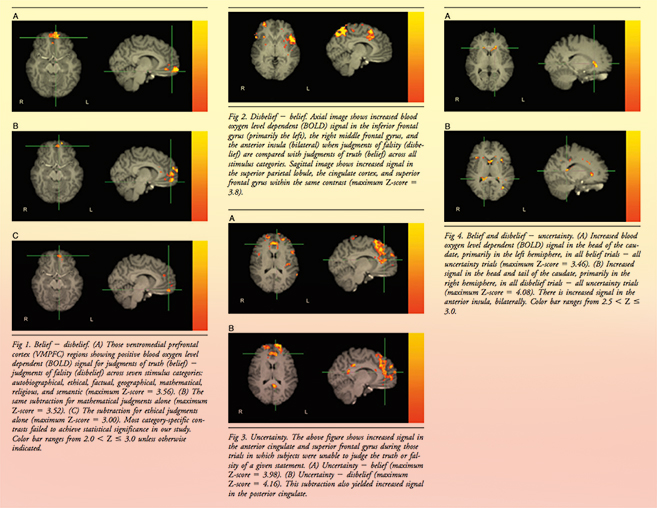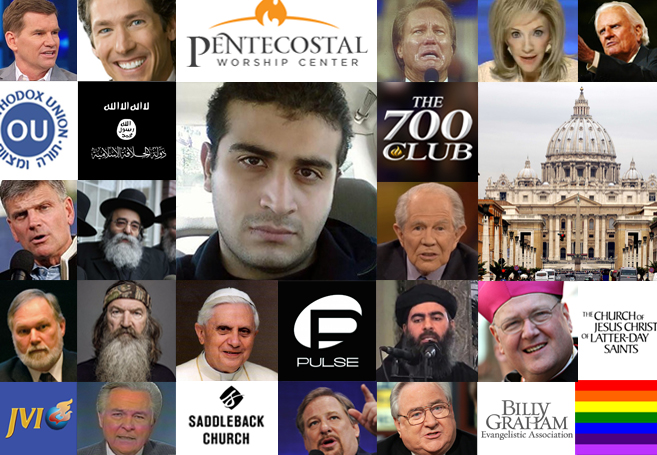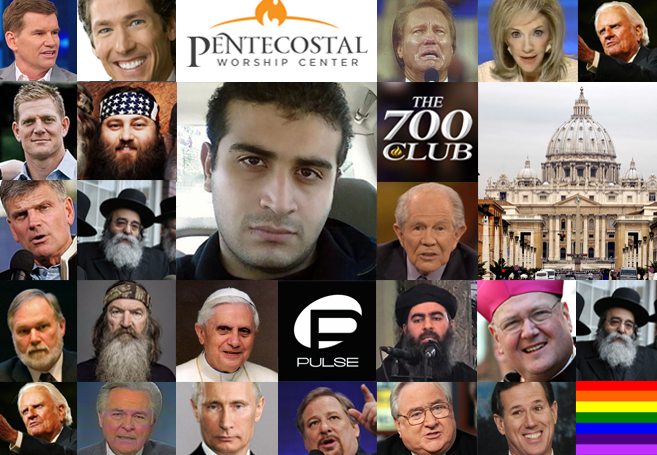In the aftermath of the Orlando shootings at the gay nightclub, PULSE, which killed 49 innocent LGBT victims, and injured at least 53 more, many well-intentioned folks are mistakenly pinning the cause of the violence on lack of gun control. As neuroscientist, author, and acclaimed philosopher, Sam Harris, Ph.D., wisely tweeted: “I favor gun reform, but was the Boston bombing also ‘about pressure cookers’? Focus on the cause, not the means.” What drove the gunman, Omar Mateen, to pull the trigger — and “laugh uncontrollably” as he did so — was not a determination to kill randomly. Mateen’s motives were driven by a viciously warped and radicalized interpretation of Islam which deems homosexuality as a moral crime punishable by death. And new reports indicate Mateen was gay and struggling with his own sexuality — an internal civil war triggered by a lifetime of brainwashing from a homophobic religion.
Gun control may certainly have prevented the attack — or at the very least lowered the death toll — but it would still only be treating the symptom and not the cause. The true cause of these barbaric attacks comes from fundamentalist religions. “A 2009 poll by Gallup found that zero percent of Britain’s Muslims believed homosexual acts to be morally acceptable. What previous polls have shown us time and again is more of the same,” writes Majid Nawaz for The Daily Beast in his op-ed entitled “Why Does Gay Sex Scare Modern Muslims? It Didn’t in the Golden Age”. Nawaz, who was once a former jihadist himself, explains how Islam was originally very pro-gay. “But as prudish Victorian values spread from Europe to the Middle East through colonialism,” explains Nawaz, “and as 19th century neo-fundamentalist Wahhabism began to take hold in the Arabian peninsula, and as 20th century Islamism gained ground, spreading from Egypt around the globe, censorship, misogyny and homophobia began to spread among Muslims worldwide.”
The Orlando shootings have also opened the door to hypocrisy on the part of Westerners who feel this type of deadly homophobia can only find its roots in the Middle East, and who assume that the Western world is now 100% gay friendly in the year 2016 — sadly, it most certainly is not. In an op-ed for The Telegraph, entitled “Islam Does Have A Problem With Homosexuality, But So Do Western Conservatives”, Tim Stanley writes: “When we ask Muslims to interrogate attitudes towards sexuality in their community, we do so assuming that our own culture is 100% gay friendly. It is not. Polls suggest that around 1/3 of Americans still believe that homosexuality should be discouraged. Homosexual acts have only been legal in the West since the 1960s. Gay marriage has only been on the agenda for a decade and is still bitterly resented by social conservatives.” LGBT citizens have fought for equal rights and protection with much success in the West, but tragically, there are far more nations where the LGBT community is being assaulted, imprisoned, executed, and murdered (and reports from the world’s top journalists are tracing the roots of this violence directly to North America’s top Evangelical leaders).
.
The Orlando massacre begs the question: how does a human brain get hijacked and brainwashed
by homophobic fundamentalist religions such as Islam, Evangelicalism, Catholicism, and Orthodox Judaism?
A recent scientific study entitled “Beliefs About God and Mental Health Among American Adults“,
published in the Journal of Religion & Health (Volume 53, Issue 5 , pp 1285-1296; DOI: 10.1007/s10943-013-9712-3),
shows how those who believe in an angry, punishing God are far more likely to suffer from a wide range
of mental illnesses. Stephen Webster of The Raw Story writes:
.
“[The study] used data from the 2010 Baylor Religion Survey of US Adults to examine the links between beliefs and anxiety disorders like social dysfunction, paranoia, obsession and compulsion. To do this, Silton viewed the data through the lens of what’s called Evolutionary Threat Assessment System Theory, which posits that parts of the brain specifically evolved to detect threats, and suggests that many anxiety disorders may be a result of dysfunction in the brain’s perception of those threats. In keeping with prior studies on this very subject, she queried the data on three types of believers: those who see God as angry, those who see God as neutral and those who see God as loving. Controlling specifically to weed out the non-believers, Silton found that a belief in a forgiving, loving God [i.e. Episcopaliansim, Anglicanism, Unitarianism] is associated with positive psychological traits, ‘almost protecting against psychopathology,’ she told Raw Story. But for those who think God is angry and preparing punishments for sinners [i.e. Evangelicalism, Islam, Orthodox Judaism, Catholicism], ‘that belief seems to be very much related to these negative symptoms, Silton said. ‘If you look at the previous research, they’ve connected it to depression and all sorts of other psychiatric disorders,’ she said. ‘We were looking at social phobia, obsession, compulsion, paranoia and a lot of features of anxiety disorders.'” The research team is conducting further research which looks at more qualitative questions such as “what else belief systems might be related to.” You can read the full story by visiting RawStory.com.
Another scientific study exploring the psychological mechanics of homophobia was conducted in Italy. The research team was led by Dr. Emmanuele A. Jannini, president of the Italian Society of Andrology and Sexual Medicine, and the results of the study, entitled “Psychoticism, Immature Defense Mechanisms and a Fearful Attachment Style are Associated with Higher Homophobic Attitude”, were published by in the Journal of Sexual Medicine (Volume 12, Issue 9, pages 1953–1960, September 2015; DOI: 10.1111/jsm.12975). Kristin Magaldi of Medical Daily writes: “After evaluating participants’ scores, the team first discovered that homophobia was more likely to be reported in men than women. They also found that those who displayed homophobia were more likely to utilize immature defense mechanisms, suggesting a maladaptive and problematic approach to uncomfortable social situations. Finally, and most importantly, researchers found evidence for psychological traits within homophobic individuals; these people were more likely to display psychoticism, which, in extreme cases, could be a predictor of psychotic disorders like schizophrenia, as well as personality disorders. In minor forms, psychoticism manifests as states of hostility and anger. On the other hand, participants who showed more neurotic forms of defense mechanisms, along with depression, were less likely to display homophobic traits. Jannini believes this is just another way to confirm that homosexuality is not the problem, but rather those who find issue with it are. ‘After discussing for centuries if homosexuality is to be considered a disease, for the first time we demonstrated that the real disease to be cured is homophobia, associated with potentially severe psychopathologies,’ he said.”
It’s not a coincidence that the bulk of this research has found that men have the highest rates of homophobia. What might surprise some, however, is how science is proving time and time again that the most homophobic individuals tend to have the highest levels of homosexual desire. Research out of the University of Georgia found some shocking results. “[The study] asked heterosexual men how comfortable and anxious they are around gay men. Based on these scores, they then divided these men into two groups: men that are homophobic, and men who are not. These men were then shown three, four-minute videos. One video depicted straight sex, one depicted lesbian sex and one depicted gay male sex. While this was happening, a device was attached to each participant’s penis. This device has been found to be triggered by sexual arousal, but not other types of arousal (such as nervousness, or fear — arousal often has a very different meaning in psychology than in popular usage). When viewing lesbian sex and straight sex, both the homophobic and the non-homophobic men showed increased penis circumference. For gay male sex, however, only the homophobic men showed heightened penis arousal. Heterosexual men with the most anti-gay attitudes, when asked, reported not being sexually aroused by gay male sex videos. But, their penises reported otherwise. Homophobic men were the most sexually aroused by gay male sex acts.”
Furthermore, a new study published by the Journal of Personality and Social Psychology, and the American Psychological Association, confirms that it is impossible for a person to be 100% heterosexual. The research was led by Ritch C. Savin-Williams, Ph.D, Director of Developmental Psychology and the Director of the Sex and Gender Lab in the Department of Human Development at Cornell University.
By studying the physiological responses of participants exposed to pornographic material (i.e. measuring genital arousal and pupil dilation), the researchers found that 100% of participants bodies’ responded positively when viewing heterosexual or homosexual sex. Diana Tourjee of Broadly writes, “Following popular logic, sexuality is thought of as straight or gay. Bisexuality has only recently begun to be taken seriously. The idea of separate, static, and neatly defined sexual orientations is woven into the fabric of American society and is part of our cultural conception of gender itself; real men are masculine and attracted to women. The results of Savin-Williams’ study challenges deeply held cultural beliefs about sexuality, but he’s not surprised to find that sexuality is more complex than gay and straight. ‘I’m certainly not surprised,’ he says. ‘We’re trying to get at the way people really are. Sometimes, it seems people are one way but believe they have to report themselves in another way, and that’s not good.'”
.
Savin-Williams adds, “There are aspects [of male sexuality] along a continuum,
just as we have always recognized with women. Men have gotten so much cultural crap
put on them that even if a man does have some sexual attraction to guys, they would never say it.”
Society has long embraced the sexual fluidity of women, but over years of research Savin-Williams
has found the number of men who no longer consider themselves as 100% straight is growing.
.
Savin-Williams says, “Sexuality exists along a spectrum with degrees of heterosexuality and homosexuality, and yet we continue to categorize people as if the only options are gay, straight, or bi. But new research shows this is changing, especially among young adults who tell us self-identify outside of these three so-called ‘traditional’ categories. The largest of these new sexualities is the mostly straight — heterosexuals with a small degree of gayness. Indeed, more individuals identify as mostly, but not all together, straight than who identify as gay/lesbian or bisexual combined. Although more women, about 10%, than men, roughly 5%, claim to be mostly straight, the numbers are escalating as the current generation of youth feel little stigma with being ‘a little bit gay.’ But even those who identify as ‘mostly straight’ exist on a wide spectrum. Some only have sexual or romantic attraction for their less preferred sex, others experience a small degree of both same-sex desire and romantic infatuations, and some are willing to sexually experiment if the right woman or man comes along.”
“Research also shows self-identifying as mostly straight increases during the teenage years, peaks around the early twenties, and remains relatively stable during young adulthood,” he adds. “Many youth appreciate more options when it comes to defining their sexuality. As one young woman expressed it: ‘I sort of like that it doesn’t just have a completely or just a bisexual, but it has [an] in between … there isn’t always that black and white picture.’ Young adults today do not want their sexuality boxed in. They want alternatives and new ways to describe the complexity of their sexual and romantic selves and the research reinforces this spectral understanding of human sexuality.”
So if Orlando gumnam, Omar Mateen, was indeed struggling with repressed homosexuality, it’s important to learn more about the forces at play inside his brain. How is it possible that a fundamentalist faith can be so strong that it could repress one’s intense biological sexual desires? Philosopher and Ph.D. neuroscientist, Sam Harris, has been tackling this question head-on with his fascinating functional-neuroimaging (fMRI) research aimed at unlocking the neurological processes of faith.
In his study entitled “Functional Neuroimaging of Belief, Disbelief, and Uncertainty” (2008; 63:141–147) which you can read in full HERE, Harris describes his objective: “The difference between believing and disbelieving a proposition is one of the most potent regulators of human behavior and emotion. When one accepts a statement as true, it becomes the basis for further thought and action; rejected as false, it remains a string of words. The purpose of this study was to differentiate belief, disbelief, and uncertainty at the level of the brain.”
By studying the brains of the participants, Harris discovered how faith is rooted in the primal brain: “Belief and disbelief differ from uncertainty in that both provide information that can subsequently inform behavior and emotion. The mechanism underlying this difference appears to involve the anterior cingulate cortex and the caudate. Although many areas of higher cognition are likely involved in assessing the truth-value of linguistic propositions, the final acceptance of a statement as ‘true’ or its rejection as ‘false’ appears to rely on more primitive, hedonic processing in the medial prefrontal cortex and the anterior insula. Truth may be beauty, and beauty truth, in more than a metaphorical sense, and false propositions may actually disgust us (see Fig. 1-4 below).” Sam Harris is also the founder of Project Reason, and you can learn more this at Project-Reason.org.
One of the most extraordinary facts about the human brain is that 80% of it is formed after birth. The consequence of this is that much of what makes us who we are — our dreams, our fears, our anxieties, our perception — is shaped by our environment and our upbringing. The human brain is not fully wired until approximately 20-years-old, and its development is fragile to say the least. Anything can interrupt it — whether it’s toxic chemicals or toxic ideologies.
EDITOR’S NOTE: In the wake of the Orlando massacre, it is worth noting that LGBT murders are not exclusive to Muslim fundamentalists. Evangelical fundamentalists are responsible for thousands of deaths each year. Furthermore, countless LGBT take their own lives each and every year due to the psychological stress, shame, and feelings of self-hatred wired into them by fundamentalist religions. Research from San Francisco State University has found that LGBT youths “who experience high levels of rejection from their families during adolescence (when compared with those young people who experienced little or no rejection from parents and caregivers) were more than eight times likely to have attempted suicide, more than six times likely to report high levels of depression, more than three times likely to use illegal drugs.” A U.S. government study, titled Report of the Secretary’s Task Force on Youth Suicide, published in 1989, found that LGBT youth are four times more likely to attempt suicide than other young people. This higher prevalence of suicidal ideation and overall mental health problems among gay teenagers compared to their heterosexual peers has been attributed to minority stress. “More than 34,000 people die by suicide each year,” making it “the third leading cause of death among 15 to 24 year olds with lesbian, gay, and bisexual youth attempting suicide up to four times more than their heterosexual peers.” (source: Wikipedia)
.


[xyz-ihs snippet=”DalaiLama”]


